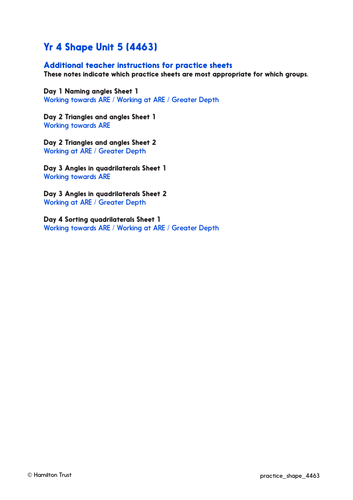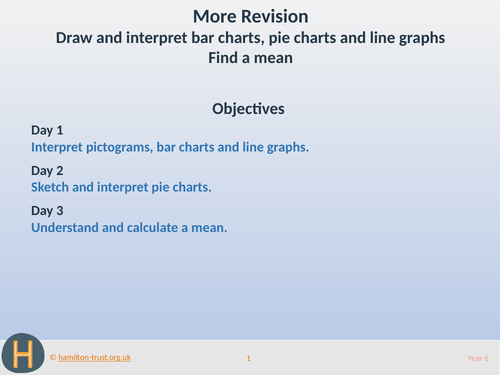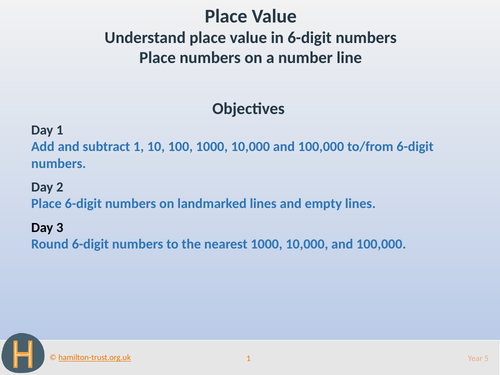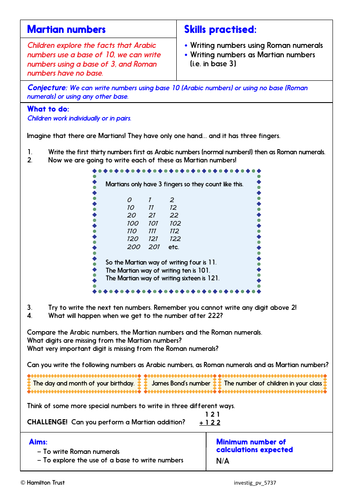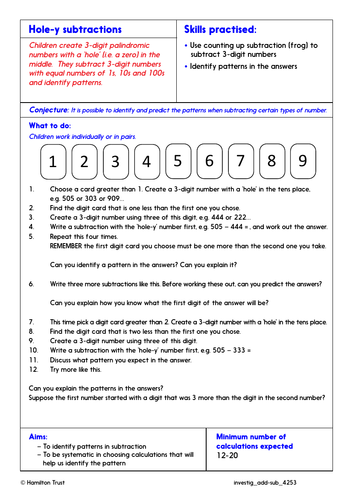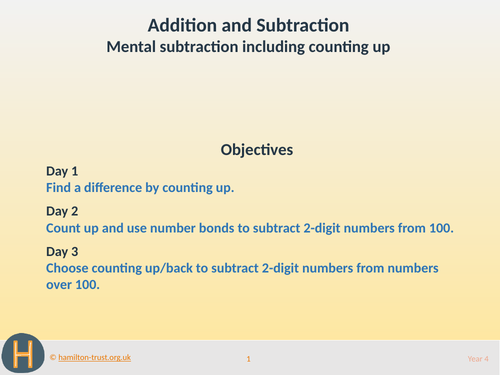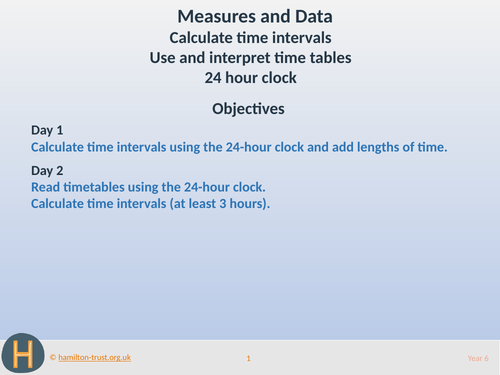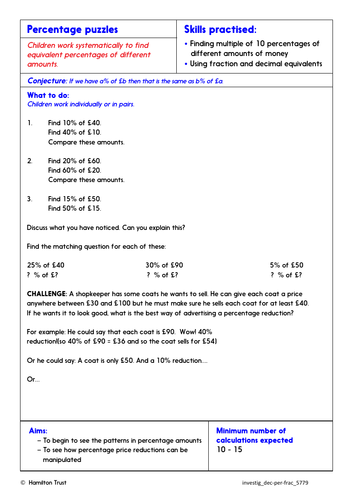
3k+Uploads
10009k+Views
11617k+Downloads
Mathematics

Angle types; properties of polygons - Practice Worksheets & Answers - Year 4
Year 4 Shape: Identify types of angle; use these in exploring properties of polygons.
Procedural fluency practice worksheets to achieve maths mastery. Differentiated for children working towards Age Related Expectations (ARE), at ARE and at greater depth. Includes answers.
Day 1 - Compare and order angles, and identify if they are acute or obtuse.
Day 2 - Identify acute, obtuse and right angles in triangles.
Day 3 - Identify acute, obtuse and right angles in quadrilaterals.
Day 4 - Sort quadrilaterals into Venn diagrams based on their properties.
These procedural fluency practice sheets are part of our Year 4 Shape block. Each Hamilton maths block contains a complete set of planning and resources to teach a term’s worth of objectives for one of the National Curriculum for England’s maths areas.

Bar charts, pie charts, line graphs, means - Teaching Presentation - Year 6
This presentation provides three days of teaching that cover the objectives:
Interpret pictograms, bar charts and line graphs.
Sketch and interpret pie charts.
Understand and calculate a mean.
It includes starter activities, whole class teaching, group activities, practice sheets and mastery questions. It can be used on a variety of interactive whiteboards.
Day 1 Teaching
Show and explain the graph of pets. How many children chose a rabbit? Discuss the scale of the graph. Draw a line down to the horizontal axis, and label it 50. Repeat with similar questions. Share today’s top tip. Show a line graph of a dog’s growth in weight over time and ask questions, including intermediate points.
Day 2 Teaching
Show children the graph of pets from day 1. Label each bar with the numbers: 50, 150 and 100. How many children were surveyed in total? 50 out of 300 children chose a rabbit, what fraction is this? (1/6). What fraction chose a dog? (1/2). What fraction chose a cat? (1/3). Children sketch a pie chart to show the results.
Day 3 Teaching
Remind children what the word average means and how the mean is one type of average. A sprinter ran 100m in times of 12s, 15s, 13s, and 16s; then calculated her mean time to be 18s. Does this sound right? Share today’s top tip for tests. Children add the 4 times together and divide by 4 to find her mean time. Take feedback. Challenge children to write three different numbers with a mean of 10.
This teaching is part of Hamilton’s Year 6 More Revision block. Each Hamilton maths block contains a complete set of planning and resources to teach a term’s worth of objectives for one of the National Curriculum for England’s maths areas

Place value in 6-digit numbers - Teaching Presentation - Year 5
This presentation provides three days of teaching that cover the objectives:
Add and subtract 1, 10, 100, 1000, 10,000 and 100,000 to/from 6-digit numbers.
Place 6-digit numbers on landmarked lines and empty lines.
Round 6-digit numbers to the nearest 1000, 10,000, and 100,000.
It includes starter activities, whole class teaching, group activities, practice sheets and mastery questions. It can be used on a variety of interactive whiteboards.
Day 1 Teaching
Write 457,849. In pairs, one child writes the number 1 less, and the other child writes the number 1 more. Repeat with 10 more/less, 100 more/less, 1000 more/less, 10,000 more/less and 100,000 more/less. Then repeat with 230,193 then 352,605.
Day 2 Teaching
Show a 0 to 1,000,000 line marked in multiples of 100,000. Choose numbers to mark so that children have to identify and label. Then ask one child to mark a number. The rest of the class guess it, asking careful questions. Children repeat with a partner to place numbers on a 100,000 to 200,000 line. Repeat for groups of numbers, using a number line bounded by appropriate adjacent multiples of 100,000.
Day 3 Teaching
Sketch a line from 200,000 to 300,000. Mark a number, then ‘zoom in’ and draw a line to show that number between two multiples of 10,000. Repeat for two multiples of 1000. Round to nearest 100,000, 10,000 and 1000. Repeat with a new child and a line between 500,000 and 600,000. Then play ‘100k Bingo.’
This teaching is part of Hamilton’s Year 5 Place Value block. Each Hamilton maths block contains a complete set of planning and resources to teach a term’s worth of objectives for one of the National Curriculum for England’s maths areas.

Identify and write Roman numerals - Problem-Solving Investigation - Year 5
This in-depth maths investigation is an open-ended problem solving activity for Year 5 children. It can be used to support teaching towards the objectives: Identify and write Roman numerals.
In-depth Investigation: Martian Numbers
Children explore the fact that Hindu-Arabic numbers use a base of 10, we can write numbers using a base of 3, and Roman numbers have no base.
This investigation will develop maths meta-skills, support open-ended questioning and logical reasoning, and enable children to learn to think mathematically and articulate mathematical ideas.
This problem-solving investigation is part of our Year 5 Place Value block. Each Hamilton maths block contains a complete set of planning and resources to teach a term’s worth of objectives for one of the National Curriculum for England’s maths areas.

Problem-Solving Investigation: Count to 20. (Year 1 Place Value)
Year 1 Place Value: Partition teen numbers; compare numbers to 20.
This in-depth Maths Investigation will develop maths meta-skills, and enable children to learn to think mathematically and articulate mathematical ideas.
In-depth Investigation: Fill in the Box
Children fill a matchbox with items and count them accurately.
This problem-solving investigation is part of our Year 1 Place Value block. Hamilton’s maths blocks present everything you need to teach a term’s worth of each required maths area together in one place.

Problem-Solving Investigation: Written subtraction (Year 4 Addition and Subtraction)
Year 4 Addition and Subtraction: Written subtraction
This in-depth maths investigation will develop maths meta-skills, and enable children to learn to think mathematically and articulate mathematical ideas.
In-depth Investigation: Hole-y Subtractions
Children create 3-digit palindromic numbers with a ‘hole’ (i.e. a zero) in the middle. They subtract 3-digit numbers with equal numbers of 1s, 10s and 100s and identify patterns in their answers.
This problem-solving investigation is part of our Year 4 Addition and Subtraction block. Each Hamilton maths block contains a complete set of planning and resources to teach a terms worth of objectives for one of the National Curriculum for England’s maths areas.

Practice Worksheets: Place 6-digit numbers on a line; round (Year 5 Place Value)
Year 5 Place Value: Place value in 6-digit numbers. Placing on a line and rounding.
Procedural fluency Practice Worksheets to achieve maths mastery. Differentiated for children working towards Age Related Expectations (ARE), at ARE and at greater depth.
Day 1
Write 6-digit numbers with digits of given values.
Write missing digits in numbers to create ascending/descending list of 6-digit numbers.
Day 2
Add/subtract 1, 10, 100, 1000, 10,000 and 100,000; preserve inequalities.
Day 3
Place 6-digit numbers on lines and round to the nearest 100 or 1000.
These procedural fluency practice sheets are part of our Year 5 Place Value block. Each Hamilton maths block contains a complete set of planning and resources to teach a terms worth of objectives for one of the National Curriculum for England’s maths areas.

Practice Worksheets: Mixed numbers and fractions of amounts. (Year 5 Decimals and Fractions)
Year 5 Decimals and Fractions: Mixed numbers and fractions of amounts.
Procedural fluency Practice Worksheets to achieve maths mastery. Differentiated for children working towards Age Related Expectations (ARE), at ARE and at greater depth.
Day 1
Write improper fractions as mixed numbers and vice versa using images of pizzas.
Day 2
Find non-unit fractions of amounts.
These procedural fluency practice sheets are part of our Year 5 Decimals and Fractions block. Each Hamilton maths block contains a complete set of planning and resources to teach a terms worth of objectives for one of the National Curriculum for England’s maths areas.

Problem-Solving Investigation: Temperature and negative numbers. (Year 5 Measures and Data)
Year 5 Measures and Data: Understand the concept of temperature and relate to negative numbers.
This in-depth Maths Investigation will develop maths meta-skills, and enable children to learn to think mathematically and articulate mathematical ideas.
In-depth Investigation: Alternating Chains
Children create chains of alternating positive and negative numbers and explore the patterns in their totals.
This problem-solving investigation is part of our Year 5 Measures and Data block. Each Hamilton maths block contains a complete set of planning and resources to teach a terms worth of objectives for one of the National Curriculum for England’s maths areas.
Bundle

Problem-Solving Investigations for Year 3 Addition and Subtraction
These in-depth Year 3 Addition and Subtraction problem-solving investigations will develop maths meta-skills, and enable children to learn to think mathematically and articulate mathematical ideas.
These open-ended mathematical activities cover the following objectives:
Using number facts to add/subtract
Add/subtract: efficient mental strategies
Using place value to add/subtract
Mental calculation – complements to 100
Use different strategies to subtract two numbers
Add 3-digit numbers using expanded addition
Subtract 2-digit numbers from numbers over 100 using counting up
In-depth Investigation: Puzzling Squares
Children use reasoning skills to solve a number puzzle. They use numbers 0 to 7 to make a total of 10 on each side of a square.
In-depth Investigation: Twisted Subtractions
Children subtract a number which is the reverse of another, e.g. 62 - 26.
In-depth Investigation: Magic 147
Children arrange the ‘nearly numbers’ in a square so that each row and column adds to Magic 147.
In-depth Investigation: Closest to 100
Following simple rules children find ways to make 100 based on four dice throws. They practise adding four numbers with a total around 100 and use this to find a solution.
In-depth Investigation: Magic Square Differences
Children use the magic square to generate two-digit numbers and explore difference patterns.
In-depth Investigation: Expanded Elevens
Children use base 10 equipment to create 3-digit numbers to add using expanded column addition.
In-depth Investigation: Pattern Subtractions
Children subtract two-digit from three-digit numbers, by counting up, and look out for patterns in the numbers.
In-depth Investigation: Next Door Additions
Children add pairs of three-digit numbers and look for patterns in the digital roots of the answers.
These problem-solving investigations are part of our Year 3 Addition and Subtraction block. Each Hamilton maths block contains a complete set of planning and resources to teach a terms worth of objectives for one of the National Curriculum for England’s maths areas.

Mental subtraction including counting up - Teaching Presentation - Year 4
This presentation provides three days of teaching that cover the objective:
Mental subtraction including counting up
It includes starter activities, whole class teaching, group activities, practice sheets and mastery questions. It can be used on a variety of interactive whiteboards.
Day 1 Teaching
Do we remember Maths Frog? He subtracts numbers by counting up from the smaller to the larger number; Frog hops along the number line; he always hops to the next 10. Ask children to use Frog to help them work out 78 – 47. Repeat for 85 – 47.
Day 2 Teaching
Display a 0–100 landmarked line. Write 100 – 85. Children use Frog to solve this, drawing hops on the line. Repeat, subtracting 2-digit numbers from 100. Sketch a bar model to go with 100 – 82 and ask children what number is missing.
Day 3 Teaching
Write 123 – 41. Children think/pair/share how they would solve it. Model Frog counting up, and counting back mentally. Write 123 – 89, 123 – 32, 123 – 50 and discuss strategies.
This teaching is part of Hamilton’s Year 4 Addition and Subtraction block. Each Hamilton maths block contains a complete set of planning and resources to teach a term’s worth of objectives for one of the National Curriculum for England’s maths areas.

Understand x 100 and ÷ 100 as inverses - Problem-Solving investigation - Year 3
Year 3 Place Value and Money: Understand multiplying and dividing by 10 and 100 (3-digit numbers) as inverse operations.
This in-depth maths investigation will develop maths meta-skills, and enable children to learn to think mathematically and articulate mathematical ideas.
In-depth Investigation: Lost Logic
Children use their knowledge of inverse operations to solve a logic problem.
This problem-solving investigation is part of our Year 3 Place Value and Money block. Each Hamilton maths block contains a complete set of planning and resources to teach a term’s worth of objectives for one of the National Curriculum for England’s maths areas.

Use short/long division in problems - Problem-Solving Investigation - Year 6
This in-depth maths investigation is an open-ended problem solving activity for Year 6 children. It can be used to support teaching towards the multiplication and division objective: use short and long division to solve problems.
In-depth Investigation: Why is it so?
Children identify a pattern in the division of a total of six numbers created using the same 3 digits. They then use algebra to explain why it is so.
This investigation will develop maths meta-skills, support open-ended questioning and logical reasoning, and enable children to learn to think mathematically and articulate mathematical ideas.
This problem-solving investigation is part of our Year 6 Multiplication and Division block. Each Hamilton maths block contains a complete set of planning and resources to teach a term’s worth of objectives for one of the National Curriculum for England’s maths areas.

Time intervals, timetables, 24-hour clock - Teaching Presentation - Year 6
This presentation provides two days of teaching that cover the objectives:
Calculate time intervals
Use and interpret time tables
24 hour clock
It includes starter activities, whole class teaching, group activities, practice sheets and mastery questions. It can be used on a variety of interactive whiteboards.
Day 1 Teaching
Revise the 24-hour clock, converting from am and pm times to the 24-hour clock. Find differences between times that children have written, demonstrating how to count up along a time line.
Day 2 Teaching
Display the timetable of trains from Thurso (see resources). Discuss how we can work out how long particular parts of the journey take. Count up to calculate time intervals.
This teaching is part of Hamilton’s Year 6 Measures and Data block. Each Hamilton maths block contains a complete set of planning and resources to teach a term’s worth of objectives for one of the National Curriculum for England’s maths areas.

Calculate areas of different shapes - Teaching Presentation - Year 6
This presentation provides three days of teaching that cover the objective:
Calculate areas of triangles, parallelograms and rectilinear shapes
It includes starter activities, whole class teaching, group activities, practice sheets and mastery questions. It can be used on a variety of interactive whiteboards.
Day 1 Teaching
Draw right-angled triangles and discuss how to find their areas by considering each as half of a rectangle. Demonstrate that this works for any triangle. Conclude area = half base × height.
Day 2 Teaching
Show a set of quadrilaterals and identify parallelograms. Demonstrate how to find the area by dividing into 2 triangles and a rectangle. Find areas and derive formula after the activity.
Day 3 Teaching
Revise finding areas and perimeters of rectilinear shapes. Show some shapes with the same perimeter. Demonstrate that these have different areas. Can you approximate the area of a bedroom floor? The area of a village? The surface area of a little finger nail? One side of a sticky note?
This teaching is part of Hamilton’s Year 6 Measures and Data block. Each Hamilton maths block contains a complete set of planning and resources to teach a term’s worth of objectives for one of the National Curriculum for England’s maths areas.

Mental addition and subtraction strategies, including frog - Teaching Presentation - Year 5
This presentation provides three days of teaching that cover the objective:
Mental addition and subtraction strategies, including frog
It includes starter activities, whole class teaching, group activities, practice sheets and mastery questions. It can be used on a variety of interactive whiteboards.
Day 1 Teaching
Use spinners to generate pairs of 2-digit numbers. Children add and subtract; briefly share strategies. Write additions and subtractions with related multiples of 10 and 100, e.g. 84 + 36, 84 – 36, 840 + 360, 840 – 360; 8400 + 3600, 8400 – 3600.
Day 2 Teaching
Some folk are cycling 4000 miles. So far they’ve gone 2658 miles. Use Maths Frog to find how much further they have to cycle. Choose a child to draw an empty number line jotting. Model Frog subtraction. How far to go once they reach 3452 miles?
Day 3 Teaching
Write 56 + ☐ = 83; ☐ + 56 = 92; ☐ – 23 = 46; 73 – ☐ = 42. Children discuss in pairs how to work out the missing numbers. Draw out that sometimes we need subtraction to solve an addition or addition to solve subtraction. Using 2 spinners, children work out missing numbers in number sentences with pairs of 2-digit numbers and pairs of multiples of 10.
This teaching is part of Hamilton’s Year 5 Addition and Subtraction block. Each Hamilton maths block contains a complete set of planning and resources to teach a term’s worth of objectives for one of the National Curriculum for England’s maths areas.

Begin to understand percentages - Problem-Solving Investigation - Year 5
This in-depth maths investigation is an open-ended problem solving activity for Year 4 children. It can be used to support teaching towards the objectives: Begin to understand percentages.
In depth Investigation: Percentage Puzzles
Children work systematically to find equivalent percentages of different amounts.
This investigation will develop maths meta-skills, support open-ended questioning and logical reasoning, and enable children to learn to think mathematically and articulate mathematical ideas.
This problem-solving investigation is part of our Year 5 Decimals, Percentages, Fractions block. Each Hamilton maths block contains a complete set of planning and resources to teach a term’s worth of objectives for one of the National Curriculum for England’s maths areas.

Mental Oral Starters - Year 4
Mental and oral starters for Year 4 Autumn Teaching Sequence 11.
Understand how subtraction ‘undoes’ addition. Understand how halving undoes doubling. Understand how division is the inverse of multiplication. Know by heart multiplication facts for the 2, 3, 4, 5, 9 and 10 times tables. Recognise multiples of 3 and 4 up to at least the 10th multiple. Know all multiplication facts for the 9 times table.
Find additional lesson plans and resources at www.hamilton-trust.org.uk.

Mental Oral Starters - Year 2
Mental and oral starters for Year 2 Summer Teaching Sequence 6.
To work out what coins to use to pay an amount up to £2. To find pairs of multiples of ten with a total of 100. Recognise all coins. Find totals up to 20p using two or more coins. Find totals up to 50p using two or more coins. Use pairs to ten to find the complement to the next multiple of ten. Use complements to multiples of ten to find change up to 50p . Find pairs of multiples of ten with a total of 100.
Find additional lesson plans and resources at www.hamilton-trust.org.uk.

Mental Oral Starters - Year 2
Mental and oral starters for Year 2 Autumn Teaching Sequence 12.
To know doubles to double 10 and corresponding halves. To know halves of even numbers up to half of 20.
Find other lesson plans and resources at www.hamilton-trust.org.uk.

